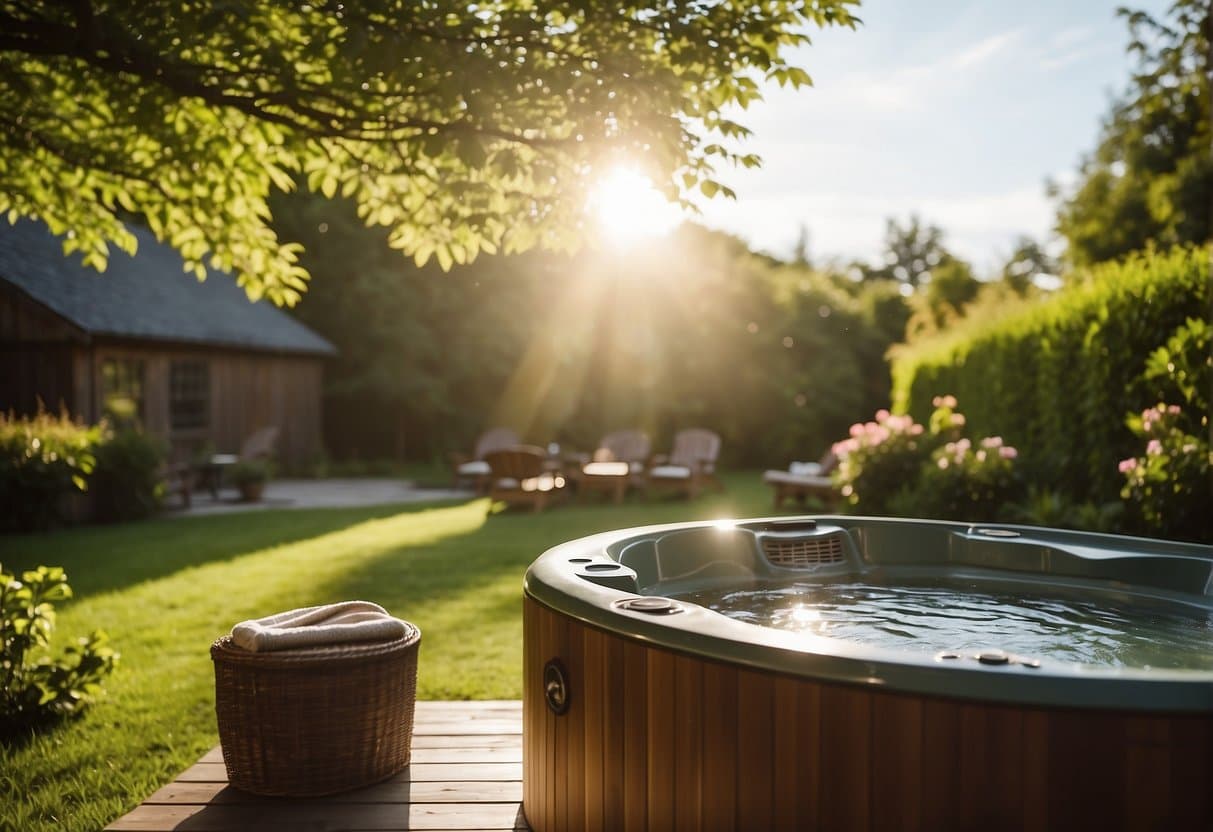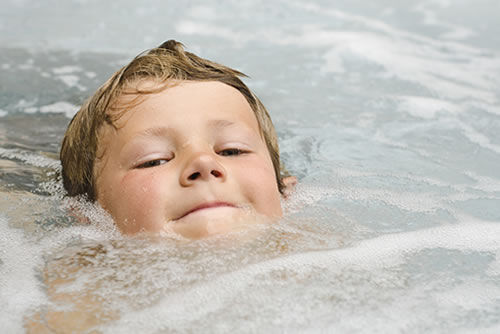Listen, we understand. On a sweltering July afternoon, you’ve undoubtedly found yourself standing by your hot tub, wondering if you’ve gone insane for wanting to soak in hot water when the temperature is already 90°F. The problem is that there is a sweet spot that makes summertime hot tubbing truly refreshing rather than just tolerable.
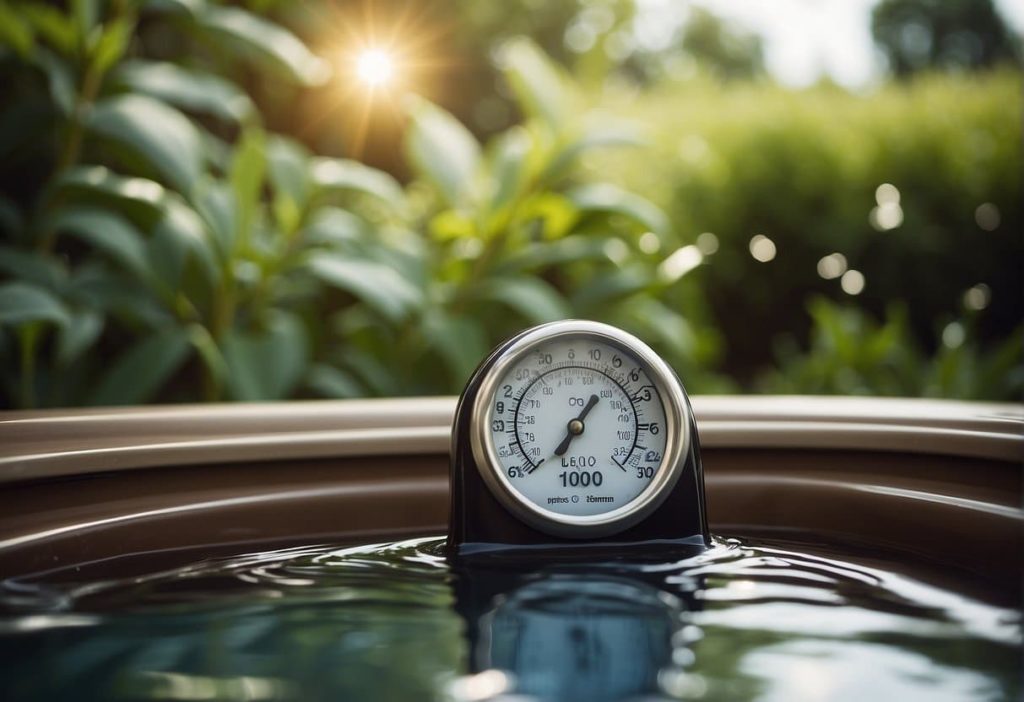
The quick response? The ideal temperature range for summertime hot tubbing is between 85 and 90°F (29 and 32°C). That’s significantly colder than the usual range of 100 to 104°F that most people associate with hot tub temperatures. Honestly, after you give it a try, you’ll question why you ever believed that in order to enjoy your spa, you had to poach yourself like an egg.
For years, we have been assisting Canadian families in creating the ideal outdoor recreation space, and during the scorching summer months, the topic of temperature is frequently raised. After talking to hot tub owners all over the nation, we’ve discovered that maintaining the ideal summer temperature isn’t just about comfort; it’s also about making the most of your investment rather than letting it gather leaves all season long.
Knowing the Temperature of a Hot Tub (Without Getting Too Technical)
The Fundamentals That Are Most Important
Since that’s where safety measures draw the line, the majority of hot tub manufacturers set their maximum temperature at 104°F (40°C). If you go above that, you run the risk of developing heat stroke, which is not what you were hoping for when you wanted to unwind.
The interesting thing is that most people never really use their hot tub at its highest setting. During cooler months, we’ve discovered that most of our customers find a sweet spot between 98 and 102°F. During the summer? That figure dramatically declines.
Consider this: your body temperature is approximately 98.6°F. Jumping into water that is just a little bit warmer than your body temperature feels surprisingly calming when it’s 85°F outside and sunny. You can relax your muscles without feeling like you’re melting because it’s warm enough.
Why Everything Is Actually Changed by Climate
Although that would be something, your hot tub doesn’t exist in a vacuum. Whatever Mother Nature throws at you must be accommodated by the temperature you select.
It may surprise you to learn how quickly direct sunlight can heat your water. In Calgary, we had a customer whose south-facing hot tub would rise from 95°F to over 100°F simply by being exposed to afternoon sunlight. Conversely, the water may remain cooler for a longer period of time if your spa is located next to trees or beneath a deck.
The temperature of the air is also very important. That 90°F water feels just right when the temperature outside is 75°F. However, that same temperature feels like a refreshing retreat when you’re dealing with those harsh 95°F days—yes, even Canadians experience them.
Additionally, the humidity factor is real. Your ideal hot tub temperature may need to drop even further on those humid August evenings because high humidity makes everything feel hotter.
Safety and Health (Because No One Wants to Steal the Fun)
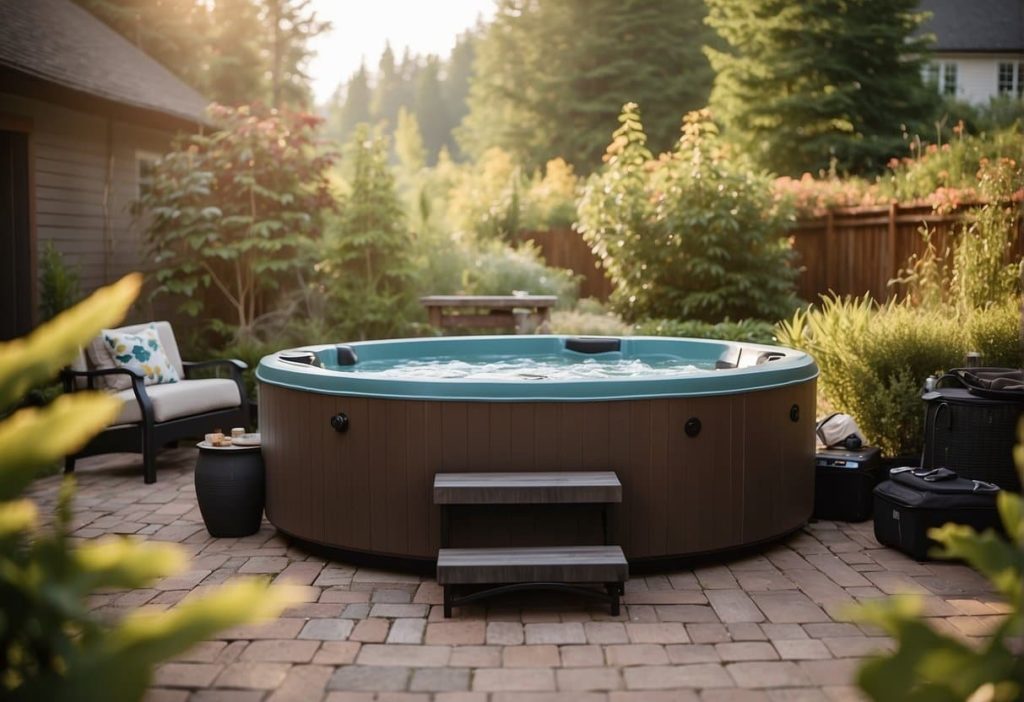
Various People, Various Temperatures
There is no one-size-fits-all solution here, so not everyone should be soaking at the same temperature. Ignoring the fact that children, pregnant women, and elderly people all have varying temperature tolerances can make leisure time unhealthy.
Youngsters under the age of sixteen are especially vulnerable to heat. What feels safe to you may be dangerous to them because their bodies aren’t as good at controlling their body temperature through sweating as adults’ are. When the young ones join in, keep the temperature below 95°F and give them no more than 15 minutes to soak.
Temperatures should remain between 97 and 100°F, but pregnant women should discuss hot tub use with their doctor if they are given the all-clear. Elevated temperatures have the potential to elevate the body’s core temperature, which is undesirable during pregnancy.
Cooler is usually preferable for older adults due to circulation and blood pressure issues. With shorter session durations, the 95–100°F range is typically the safest.
The Honest Discussion of Heat-Related Concerns
We have seen it happen: on a day when it is 90°F, someone sets their hot tub to 104°F, and after 20 minutes, they question why they feel dizzy. You must therefore exercise caution when controlling your temperature. Both saunas and hot tubs can cause heat exhaustion, especially when high water and air temperatures are combined.
Keep an eye out for symptoms such as lightheadedness, nausea, a fast heartbeat, or fainting. Get outside, cool down, and drink plenty of water if any of these occur. When you feel better, the hot tub will still be available.
Consult your doctor about your health, safe temperatures and soak times if you are taking any prescription drugs because blood pressure medications can make people more sensitive to heat.
Summertime Hot Tub Maintenance (The Things No One Discusses)
Maintaining the Health of Your Water Chemistry
Summer hot tubbing presents a unique set of maintenance issues that winter users never have to deal with. Increased use and outdoor factors, along with higher temperatures (even if they are lower than your winter settings), mean that your water chemistry requires more care.
Throughout the summer, chlorine levels should remain between 3 and 5 parts per million. Sunlight, heat, and increased use all cause sanitizer to degrade more quickly than you might think. If you use the tub frequently, check your levels every other day.
Summertime also makes pH balance more difficult. Aim for 7.4–7.6, but be ready to make adjustments more often. Your pH balance is upset more quickly by sunscreen, body oils, and increased sweating than it is during the cooler months.
During the summer, your filter is working extra hard. Instead of cleaning it once a month, do so every two to three weeks. In the summer, a clogged filter can cause bacterial growth more quickly than you can say “hot tub rash.”
If you use your hot tub frequently during the summer, we always advise customers to empty and refill it every three months to maintain the hot tub’s cleanliness. If you host pool parties every weekend, then more frequently. In hot weather, fresh water simply works better.
The Impact of Temperature on Your Equipment
The components of your hot tub are affected differently by summer heat, which is something that most people are unaware of. Heat and UV radiation severely damage your cover. To avoid fading and cracking, we advise applying a UV protectant spray once a month during the summer.
Since it doesn’t have to work as hard to maintain temperature for optimal performance during the summer, the heater actually gets a break. This is fantastic for your electricity bill, but it also means that you may not be aware of heater issues until fall arrives and the water starts to struggle to heat.
Because oils and sunscreen can clog the nozzles, jets require extra care during the summer. Every week, give them a thorough cleaning, and remember to run the jets frequently to maintain proper circulation.
Technologies for Temperature Control (Getting Fancy)
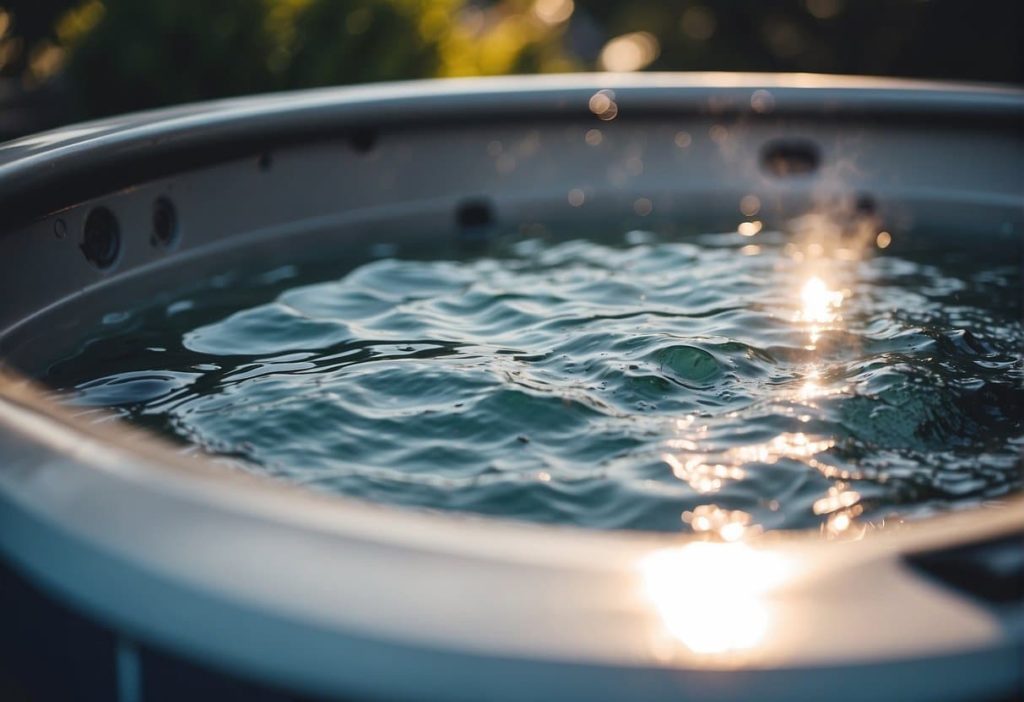
Contemporary Options for Heating and Cooling
The hot tubs of today are not the same as the simple models of your father. Your preferred temperature can be maintained with energy-efficient heating systems without breaking your hydro bill, and some more recent models even come with cooling features for summer use.
The ability of circulation pumps to maintain steady temperatures without continuously running the main heater has greatly improved. This implies that rather than varying throughout the day between 87°F and 93°F, your 90°F summer setting remains at 90°F.
In the summer, economy mode is your friend. The majority of contemporary hot tubs feature settings that automatically change the temperature according to usage trends and external conditions. Let the spa do the thinking after you’ve set it up once.
Intelligent Temperature Control
Summer mode isn’t just marketing speak; it’s a practical setting that can improve your hot tub’s comfort and save you money. With little energy consumption, this mode usually keeps temperatures in the 85–95°F range we’ve been discussing.
In the summer, scheduled heating can make all the difference. In the evening, when you’re more likely to use your hot tub, set it to warm up a little and cool down during the hottest part of the day. This keeps it from overheating and guarantees that it will be ready when you want to soak.
Even if you want to keep things cooler, proper insulation is still important. Without the heater turning on and off all the time, a well-insulated hot tub maintains a constant temperature.
Improving Your Experience with a Summer Hot Tub
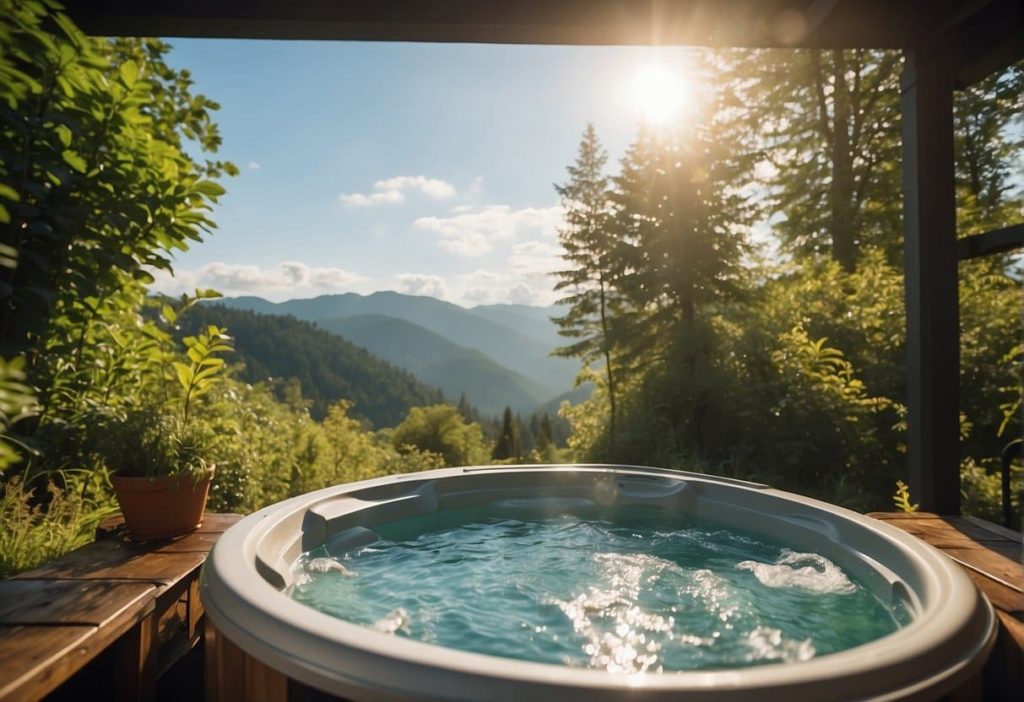
Discovering Your Own Sweet Spot
Everybody has a different ideal temperature, and summer adds another factor. Even on hot days, some people still prefer the warm, comforting sensation, while others enjoy the contrast of cool water.
Depending on the outside temperature, the time of day, and your own preferences, start at 90°F and work your way up. For afternoon soaks, you may find that 85°F is ideal, but for evening relaxation sessions, you may want to raise the temperature to 95°F.
The cooling effect is genuine; on a hot summer day, water that is 10 to 15 degrees colder than normal hot tub temperatures can feel wonderfully cool. It’s similar to having a pool that’s just warm enough to help you unwind.
Enhancing Comfort in the Summer
In addition to being aesthetically pleasing, water features like spillovers and fountains aid in cooling the water through evaporation. Additionally, in hot weather, the sound of flowing water feels more revitalizing.
In the summer, aromatherapy takes on a new significance. Citrus scents go well with those sunny afternoon soaks, while eucalyptus and peppermint scents can cool even warm water.
For hot tubbing in the summer, shade becomes essential. Protecting yourself from direct sunlight, whether with a large umbrella, retractable awning, or permanent pergola, significantly alters the feel of the water’s temperature.
For evening soaks, think about using LED lighting. LEDs keep things cool while creating a relaxing atmosphere at night, while regular incandescent bulbs add needless heat.
Environmental and Economic Factors (Your Pocketbook Will Appreciate It)
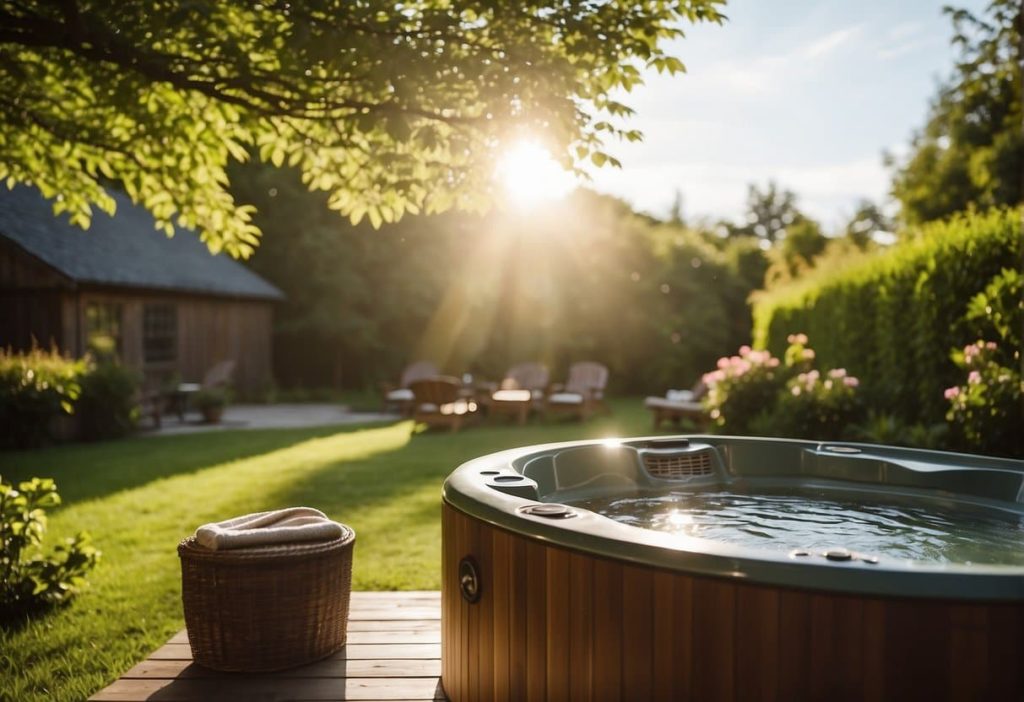
Saving Energy With Intelligent Temperature Control
You might be surprised to learn that you can save up to 30% on summer heating expenses by lowering the temperature of your hot tub from 102°F to 90°F. That puts actual cash back into your pocket.
You can maximize your energy use with the aid of smart thermostats and remote monitoring. Configure your hot tub to warm up before you usually use it and to cool down when no one is home. You might be surprised at how quickly the energy savings mount up.
Your heating elements and other parts will last longer if you run at lower temperatures. Future repair costs will be lower when the system is under less stress.
Sustainable Summertime Activities
Solar covers can be used to control the temperature of hot tubs as well as pools. To avoid overheating, use one during the day and take it off for use at night.
In the summer, when chemical loads are lower, natural cleaning techniques are especially effective. Natural clarifiers and enzyme-based cleaners can maintain the glistening quality of your water while being more environmentally friendly.
Waste is avoided with routine maintenance. A properly maintained hot tub requires fewer chemical additions, less energy, and fewer water changes. Both the environment and your pocketbook will benefit from it.
Frequently Asked Questions
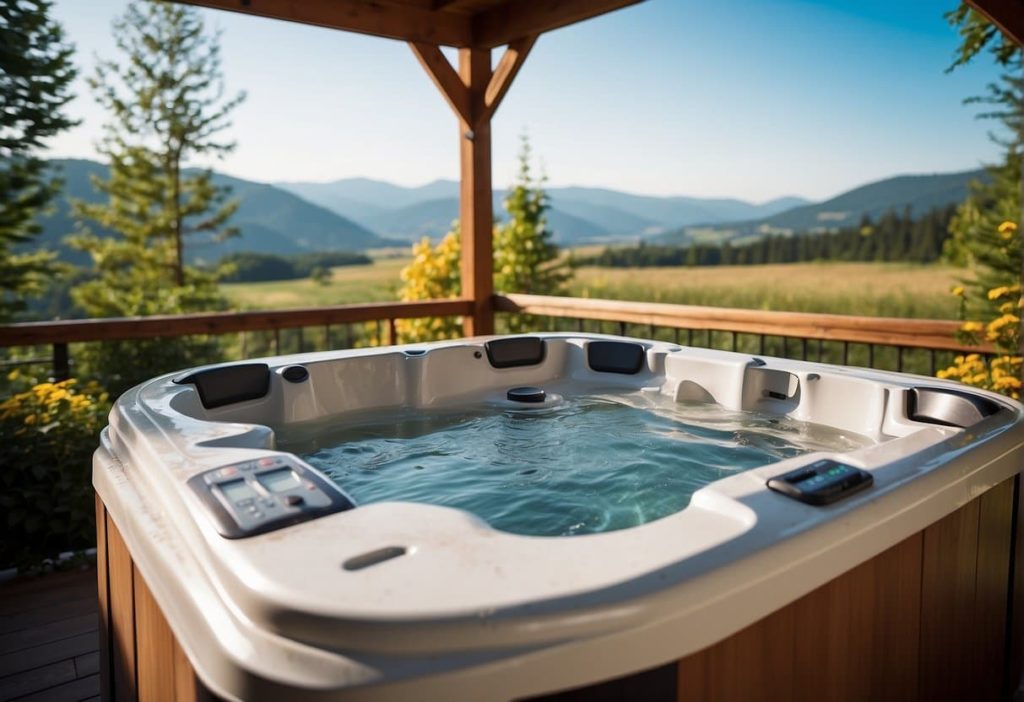
What Is Safe for Children?
This is a common question we get, especially from families with young children. Never expose children to temperatures above 95°F. In all honesty, though, 90°F is safer and more comfortable for them when they play for longer periods of time, which is why adult supervision is necessary.
Regardless of the temperature, always keep an eye on kids in hot tubs. Children differ in how sensitive they are to heat, so what one child finds comfortable may be too much for another.
Is It Possible to Use My Hot Tub Like a Pool?
Of course! In essence, your hot tub becomes a warm pool when you set it to 85–88°F. On days when you want to cool off but don’t want the shock of cold water, this is ideal.
Because it is safe for kids and comfortable for adults, this temperature range is especially ideal for families. Everyone benefits.
How Frequently Should I Change the Temperature?
Most of our customers find their summer sweet spot and stay there rather than constantly adjusting. However, if you use your hot tub for different purposes or during different seasons, such as winter, having two or three preferred temperature settings can be helpful.
Evening relaxation sessions may require 92°F, while morning coffee soaks may be pleasant at 88°F. Determine what suits your routine.
What About Women Who Are Expectant?
Though this is always something to discuss with a healthcare professional, temperatures below 100°F are generally considered safer during pregnancy because heatstroke, which can be fatal for some adults, can occur at just 106 degrees. Our recommended 90–95°F summer temperature range falls well within most guidelines.
It’s still crucial to keep session lengths to a maximum of 15 to 20 minutes and to drink lots of water before, during, and after.
Consider Other Bathers
Think about who will be using the tub and how that might impact the temperature you select.
Kids younger than sixteen. Children are more heat-sensitive. Sweating cannot control their body temperature. Therefore, when children are soaking in a hot tub, the temperature should never rise above 90 degrees.
Women who are expecting. Pregnant women should avoid spas in certain situations, regardless of the temperature.
Medically ill bathers. Warm water can make people who are taking medication drowsy. Even worse, some people might feel tight in their chest and out of breath.
A hot tub’s temperature is influenced by the number of people using it. In general, the water feels colder when there are more people present. After the bathers have left, you might find the water intolerable, so use caution when adjusting the hot tub’s temperature.
Maintain Consistent Temperatures
After you’ve found the perfect temperature, don’t move the thermostat. To save energy, some people prefer to lower the temperature and then raise it a few hours before entering. The circuit boards and heating components are under stress as a result. This may even raise your operating expenses in the long run. It only makes sense to lower the temperature for prolonged periods of time, like during a vacation.

